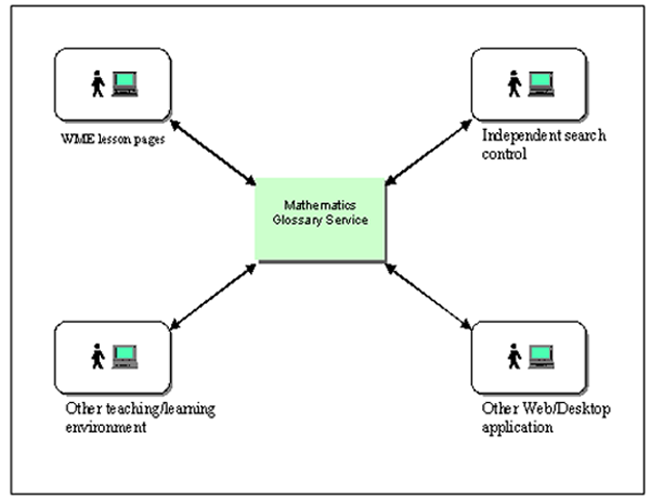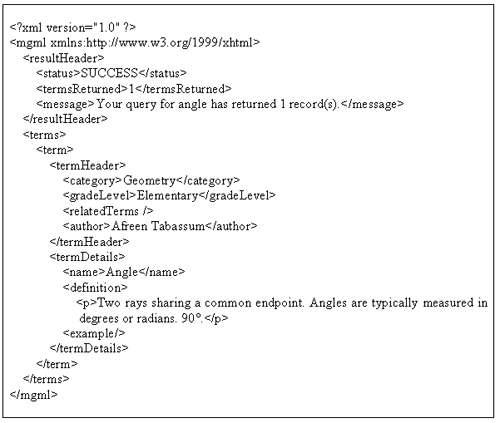
|
|
| | Mathematics Glossary System | MG Web App | MG Web Service | MG Client | Software | About Author | |

MG supports its interoperability and exchangeability with other applications through the MG Web Service. It is used to retrieve mathematical contents in a structured fashion. MG Web Service provides a standard means of interoperable mathematics definitions, examples, images, links between different software applications, running on a variety of platforms and/or frameworks.
MG Web Service can be used in different learning environments. It can generate well defined structures which provide exchangeability and makes full use of mathematics education resources over the Web. To achieve the interoperability of the system, we have designed an XML based markup Mathematics Glossary Markup Language (MgML).

Figure 1: Mathematics Glossary Web Service
- One central service can be used from any where without installing any software or maintaining a server. It can be utilized by several clients, all of which employ the operations provided to fulfill different objectives. Instead of creating a custom service for each unique requirement, portions of a service can be reused as necessary.
- Provides structured data which is interoperable with any Web application or service. MG Web Service supplies formal and in-depth explanations of mathematics knowledge with MgML structure elements.
- A programmable application, accessible as a component via standard Web protocols like HTTP, XML and SOAP.
- Ease of integration and platform independence. The service can be easily integrated with other pieces of software. It can run on all kinds of machines, from desktop to mainframe, either within the enterprise or at external sites.
MG Web Service API, supported by a set of PHP functions provides applications to programmatically access of the glossary data. It supports both SOAP and REST based Web Service.
SOAP Web Service: The SOAP Web Service allows users to access data remotely. In order to access data through the Web Service, users need to have a SOAP client. The simplest way to create a SOAP client is through the WSDL file. The WSDL file can be found at: http://boar.cs.kent.edu/Glossary/SiteEngine/glossarysoapservice.php?wsdl. For this SOAP based implementation, an open source toolkit NuSOAP is used. NuSOAP is a collection of PHP classes that allows users to send and receive SOAP messages over HTTP. This toolkit makes it very simple and easy to write SOAP based Web Services and clients in PHP.
REST Web Service: MG Web Service also exposes methods based on REST design principles for making a Web Service call by simply using a URL string, http://boar.cs.kent.edu/Glossary/SiteEngine/glossaryrestservice.php? as the endpoint with parameters. REST uses URLs with specific name/value pairs to request information or invoke processing from Web Services. The response is a well formatted MgML document.
Mathematics Glossary Markup Language (MgML)
Mathematics Glossary Markup Language (MgML) is an XML based language for describing mathematics terminologies. MgML is the key component of Mathematics Glossary system. It is a declarative language used to express detailed and structured mathematical knowledge. Glossary markup language is made up of MgML, MathML and XHTML elements. An MgML processor dynamically generates content based on the request from the users. All MgML elements are encapsulated in the <mgml /> element. Figure 2 displays a simple representation of a term "Angle" using MgML:

Figure 2: MgML Document